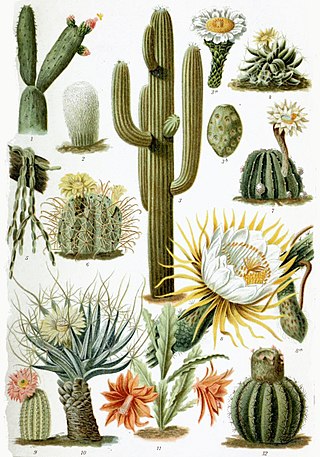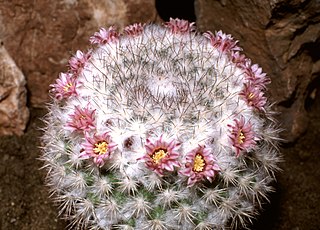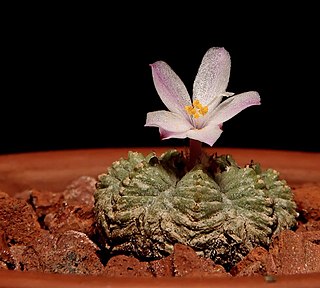
A cactus is a member of the plant family Cactaceae, a family comprising about 127 genera with some 1,750 known species of the order Caryophyllales. The word cactus derives, through Latin, from the Ancient Greek word κάκτος (káktos), a name originally used by Theophrastus for a spiny plant whose identity is now not certain. Cacti occur in a wide range of shapes and sizes. They are native to the Americas, ranging from Patagonia in the south to parts of western Canada in the north, with the exception of Rhipsalis baccifera, which is also found in Africa and Sri Lanka. Cacti are adapted to live in very dry environments, including the Atacama Desert, one of the driest places on Earth. Because of this, cacti show many adaptations to conserve water. For example, almost all cacti are succulents, meaning they have thickened, fleshy parts adapted to store water. Unlike many other succulents, the stem is the only part of most cacti where this vital process takes place. Most species of cacti have lost true leaves, retaining only spines, which are highly modified leaves. As well as defending against herbivores, spines help prevent water loss by reducing air flow close to the cactus and providing some shade. In the absence of true leaves, cacti's enlarged stems carry out photosynthesis.

Bauhinia × blakeana, commonly called the Hong Kong orchid tree, is a hybrid leguminous tree of the genus Bauhinia. It has large thick leaves and striking purplish red flowers. The fragrant, orchid-like flowers are usually 10 to 15 centimetres across, and bloom from early November to the end of March. Although now cultivated in many areas, it originated in Hong Kong in 1880 and apparently all of the cultivated trees derive from one cultivated at the Hong Kong Botanical Gardens and widely planted in Hong Kong starting in 1914. It is referred to as bauhinia in non-scientific literature though this is the name of the genus. It is sometimes called the Hong Kong orchid. In Hong Kong, it is most commonly referred to by its Chinese name of 洋紫荊 (yèuhng jígīng).

Mammillaria is one of the largest genera in the cactus family (Cactaceae), with currently 200 known species and varieties recognized. Most of the mammillaria are native to Mexico, but some come from the southwest United States, the Caribbean, Colombia, Venezuela, Guatemala and Honduras. The common name "pincushion cactus" refers to this and the closely related genus Escobaria.

Schlumbergera is a small genus of cacti with six to nine species found in the coastal mountains of south-eastern Brazil. These plants grow on trees or rocks in habitats that are generally shady with high humidity, and can be quite different in appearance from their desert-dwelling cousins. Most species of Schlumbergera have stems which resemble leaf-like pads joined one to the other and flowers which appear from areoles at the joints and tips of the stems. Two species have cylindrical stems more similar to other cacti.

The strawberry hedgehog cactus or Engelmann's hedgehog cactus is a cactus commonly found in desert areas of the southwestern United States and the adjacent areas of Mexico, including the states of California, Nevada, Utah, Arizona, Baja California and Sonora.

Kroenleinia grusonii, popularly known as the golden barrel cactus, golden ball or mother-in-law's cushion, is a species of barrel cactus which is endemic to east-central Mexico.

Echinocereus reichenbachii is a perennial plant and shrub in the cactus family. The species is native to the Chihuahuan Desert and parts of northern Mexico and the southern United States, where they grow at elevations up to 1,500 meters (4,900 ft). This cactus earned the Royal Horticultural Society's Award of Garden Merit.
The mountain viscacha rat or mountain vizcacha rat, historically viscacha rat or vizcacha rat, is a species of rodent in the family Octodontidae. It is endemic to Argentina.

The cactus wren is a species of wren that is endemic to the deserts of the southwestern United States and northern and central Mexico. It is the state bird of Arizona, and the largest wren in the United States. Its plumage is brown, with black and white spots as markings. It has a distinctive white eyebrow that sweeps to the nape of the neck. The chest is white, whereas the underparts are cinnamon-buff colored. Both sexes appear similar. The tail, as well as flight feathers, are barred in black and white. Their song is a loud raspy chirrup; akin in the description of some ornithologists to the sound of a car engine that will not start. It is well-adapted to its native desert environment, and the birds can meet their water needs from their diet which consists chiefly of insects, but also of some plant matter. The cactus wren is a poor flier and generally forages for food on the ground. Ornithologists generally recognize seven subspecies, with the exact taxonomy under dispute.

Aztekium ritteri is a species of cactus native to the Mexican state of Nuevo León.

Mammillaria spinosissima, also known as the spiny pincushion cactus, is a species of flowering plant in the cactus family Cactaceae, endemic to the central Mexican states of Guerrero and Morelos, where they grow at elevations of approximately 1,600 to 1,900 metres. The species was described in 1838 by James Forbes, gardener of the Duke of Bedford. Botanist David Hunt collected a specimen in 1971, when he located one near Sierra de Tepoztlan, Mexico.

Cylindropuntia echinocarpa is a species of cactus known by the common names silver cholla, golden cholla, and Wiggins' cholla. It was formerly named Opuntia echinocarpa.

Parodia curvispina is a species of cactus in the genus Parodia. The small, squat green plants produce yellow flowers, green fruit and black seeds. The species is found growing in Rio Grande do Sul, Brazil.

Opuntia macrocentra, the long-spined purplish prickly pear or purple pricklypear, is a cactus found in the lower Southwestern United States and Northwestern Mexico. A member of the prickly pear genus, this species of Opuntia is most notable as one of a few cacti that produce a purple pigmentation in the stem. Other common names for this plant include black-spined pricklypear, long-spine prickly pear, purple pricklypear, and redeye prickly pear.

Ferocactus emoryi, known commonly as Emory's barrel cactus, Coville's barrel cactus and traveler's friend, is a barrel cactus in the genus Ferocactus.

Adromischus marianiae is a species of succulent plants in the genus Adromischus belonging to the family Crassulaceae.

Ferocactus hamatacanthus, commonly named Turk's Head, is a barrel cactus in the tribe Cacteae.

Leucostele terscheckii, commonly known as the cardon grande cactus or Argentine saguaro, is a large cactus native to South America and popular in cultivation.

Austrocylindropuntia subulata is a species of cactus native to the Peruvian Andes. The Latin specific epithet subulata means "awl-like", referring to the shape of the rudimentary leaves. It is also known by its common names as Eve's pin and Eve's needle.


















